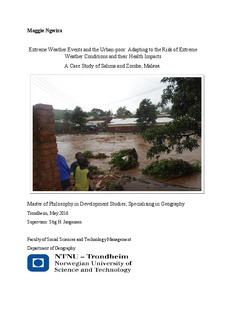| dc.description.abstract | It has become more evident that the global climate is changing, and the intensity and frequency of it is on the increase. Urban areas in Malawi are vividly and increasingly vulnerable to climate change related extreme weather conditions. This study sought to explore how urban-poor communities in Salima and Zomba are adapting to the threat of extreme weather events (EWEs) and their various health impacts. It did this by 1) identifying the occurrence of EWEs and the consequent health impacts on women and children, 2) explaining the vulnerability and adaptive capacity (resilience) of the urban-poor communities to EWEs.
The basic assumption in this study was that changes in the natural, built and social environment have positive and/or negative influence on human health, however the human-environment relation is both creator and created in the process. The study employed the triangle of human ecology, risk theory and the structuration theory to frame the understanding of concepts and issues raised. With secondary quantitative data complementing the primary qualitative data, the study collected its primary data through semi-structured interviews, focus group discussions with both primary and key informants and observations.
The study concludes that in terms of type, frequency, areal extent, intensity and impact of EWEs, urban case areas in Malawi are indeed becoming the new target of EWEs like floods, strong wind and dry spells. Different relevant fatal and non-fatal bodily and psychosomatic diseases were identified to be somehow affected by the change in the environment, behaviour and population. Although the health problems identified are not exclusive to women and children, their susceptibility is heightened by the occurrence of EWEs. However, deeper structural problems of poverty, exclusion and lack of alternatives influence the level of exposure to EWEs, sensitivity to impact and capacity to absorb, cope with and adapt to the future risks. Invisible to the government and development actors and relying on ad hoc responses to disasters, urban-poor communities are least prepared and adapted. However, with proper planning, adequate investment and coordination, urban areas are capable of adapting to and reducing the risk EWEs as well as other types of risks. | nb_NO |
